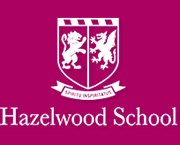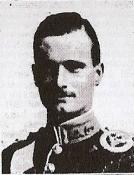
War Memorial
| Captain George Newdegate ALISON | |
|
1st Battalion Seaforth Highlanders attached to the 10th Machine Gun Company, Machine Gun Corps (Infantry) Date of birth: 28th November 1889 Date of death: 1st July 1916 Killed in action aged 26 Buried at Sucrerie Military Cemetery Colincamps Plot I Row H Grave 36 |

|
| George Newdegate Alison was born at Hamilton, Bermuda on the 28th of November 1889 the second son of Sir Archibald Alison, 3rd Baron, former Colonial Secretary of Bermuda, and Lady Georgina Sarah Ann (nee Bond-Cabbell) Alison of Possil House, Budleigh Salterton in Devon. He was educated at Hazelwood School until December 1900 when he left for a special military school. From September 1907 to 1908 he attended Cedar Court School. On the 18th of March 1908 he applied for entry to the Royal Military College, Sandhurst and successfully took the examination for admission the same month. He played cricket for the Incogniti Cricket Club and later for his battalion. He was commissioned as a 2nd Lieutenant in the Seaforth Highlanders on the 11th of December 1909 and was promoted to Lieutenant on the 9th of April 1912. From the 29th of November 1913 to the 20th of October 1914 he served as Aide De Camp to Sir Henry May the Governor of Hong Kong. Following this appointment he made his way with some difficulty via Petrograd and Archangel to England to rejoin his battalion at the front where he joined the 1st Battalion of his regiment in the field at Festubert along with one other officer and one hundred and fifty other ranks on the 20th of November 1914. On the 11th of December 1914 he was wounded by a bullet in the right buttock and his father received the following telegram dated the 13th of December 1914:- "Regret to inform you that Lieut G.N. Alison, Seaforth Highlanders, was wounded on 11th December. No further details." His father received a further telegram dated the 15th of December 1914:- "Beg to inform you that Allied Forces Base Hospital Boulogne record Lieut Alison suffering from bullet in the hip." On the 24th of December 1914 he was embarked at Boulogne on board the "Kinfauns Castle" and landed at Southampton on Christmas Day. He received a further telegram dated the 27th of December 1914:- "Beg to inform you Lieutenant G.N. Alison Seaforth Highlanders was admitted on 26th December into Campbell Hospital 10 Cambridge Square London W suffering from gunshot wound in the thigh." His father received another telegram dated the 21st of December 1914:- "Beg to inform you that Lieut Alison is reported making fair progress December 17th" On the 1st of January 1915 a Medical Board sat at Caxton Hall and reported: - "The board find that a rifle bullet entered 1" below the artery pointing downwards. He now limps but there is no pain or evidence of nerve interference."He was granted six weeks leave. On the 11th of February 1915 a Medical Board sat at Caxton Hall which concluded:- "He is improving but limps a good deal. Muscle of the hip weak. Undergoing treatment by massage reluctantly." He was granted a further six weeks leave. A Medical Board which sat at Caxton Hall on the 27th of March 1915 declared that - "He is fit for general service". He was ordered to report to the Officer Commanding the 2rd Battalion Seaforth Highlanders at Petersfield. He returned to France, was promoted to Captain on the 28th of April 1915 and was wounded once again on the 24th of May 1915. His father received the following telegram dated the 2nd of June 1915:- "Regret to inform you that Lieut. G.N. Alison Seaforth Highlanders was wounded May 24th. Further information will be wired when received." In fact he was slightly wounded and remained on duty. He was mentioned in Sir John French’s despatches of the 1st of January 1916. On the 8th of December 1915 he was seconded for service as a Brigade Machine Gun Officer and on the 22nd of December he was attached to the 10th Machine Gun Company. On the 1st of July 1916, the first day of the Battle of the Somme, his Brigade was facing the German positions to the left of Beaumont Hamel and an account of his death is given in a letter to his parents written by the General Officer Commanding his Brigade:- “Your son was one of those daring, cool men, who were invaluable. His example was always splendid, his courage magnificent; in fact he was almost too courageous. Our division was ordered to attack the German lines on Saturday the 1st of July at 7.30am. The Seaforths were on the left and the Royal Dublin Fusiliers (2nd Battalion) were on the right, Alison’s machine gun in the centre, just in the rear of the two battalions. At about 9.15 the machine gun company were just between the English and German lines, in a heavy fire and one of the sections lay down in extended order. Alison strolled over to them with one hand in his pocket-an attitude he was used to- and told them to move on. Buckworth commanded that section. “Bucky, I think you had better get on”, is what he said. He then rejoined his orderly, a man called Gould. The next thing was Alison was shot, a rifle bullet through, I think, the heart, for he merely said to Gould “I’m hit; go and tell Mr Low to take command”, but before Gould left him he was dead. Gould says he is quite sure that his Captain could not have suffered, as he was perfectly quiet and cool, and died almost at once. Your son was one of the most remarkably plucky men I ever met. I was very fond of him, and often asked his opinion and advice on matters concerning the employment of his guns. I only wish I had him with me still. We recovered his body and buried him alongside about a hundred Seaforth Highlanders. I am sure he would prefer to be near them.” His father received the following telegram dated the 3rd of July 1916:- "Deeply regret to inform you Capt. G.N. Alison Seaforth Highlanders was killed in action July 1st. The Army Council express their sympathy." He is commemorated on the war memorial at Budleigh Salterton and on the memorial at the Royal Military College Sandhurst. |
|
Back